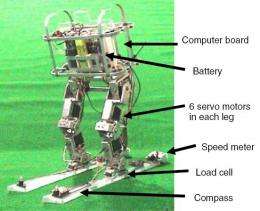July 20, 2009 feature
Ski Robot Could Decipher the Art of Skiing

(�鶹��ԺOrg.com) -- Watching an Olympic skier perform a downhill slalom, turning smoothly around the flags, makes the sport seem just as much an art as a science. Although advanced skiers know how to turn effectively, the exact physical mechanisms involved remain elusive, as there is no complete set of objective criteria to define joint motions, posture, and all the other motions that go into making the turn. To try to gain a better understanding of the kinematics of optimized skiing, researchers have recently built a ski robot that can simulate the movements of professional skiers, allowing for direct measurements of the variables involved.
The team of researchers, from Kanazawa University in Japan, has taken the first steps toward developing a robot experimental system to investigate the effects of joint motions on ski turns, and ultimately serve as a model to help skiers improve their own movements. Their research is published in a recent issue of Sports Engineering.
Generally, measuring the movements of skiers - specifically, the relationship between the joint angles and ski turn quality - has been very difficult. For instance, attempts at direct measurement face technical challenges and achieve only limited precision, and computer simulations - though more precise - must make many assumptions and are difficult to validate. On the other hand, the ski robot method has the advantage of providing precise measurements with controllable, consistent movements, as long as the robot can be designed to accurately simulate a human athlete.
“There have been several attempts at researching ski turns using a skiing robot,” Takeshi Yoneyama of Kanazawa University told �鶹��ԺOrg.com. “But there have been few considerations on the conditions required to simulate human skiing with a robot. Our attempt is to clarify the considerations for developing a modeling system using a ski robot. We also wanted to express that we are approaching this subject to obtain some useful knowledge for human skiers.”
Although the researchers tried to model a real skier as closely as possible, they faced several challenges. Their robot consisted of two legs attached to skis, with a large “waist” that contained the computer and battery. They had to modify certain values, such as the ratio of the robot’s center of mass to its ski separation distance; a version of the robot with the correct human ratio was very prone to falling over. Despite (or because of) the differences in size, mass, and mass distribution, the robot was capable of performing several successful test runs on an 11-meter-long test slope covered in artificial grass with an inclination of 20°.
The robot had six servomotors in each leg to allow for six degrees of freedom, while its onboard computer controlled the sequences of the joint angles. The robot also had force sensors between each “foot” and ski, and an odometer at the rear of each ski, while a video camera at the base of the slope recorded the robot’s trajectory. The researchers could program various motions into the robot to investigate the relations among joint angles and turn trajectory. The researchers also programmed a motion plan based on the skiing style of world cup racer Gaku Hirasawa, who turns his waist to face inside the turn arc. Copying this technique made the robot’s turn faster and more stable.
Overall, the researchers found that the robot could enable them to separate and investigate the effects of each joint motion on skiing performance. Still, the robot was limited as a model due to its differences from a human being, and the researchers hope to improve the robot’s human-likeness in the future.
“Now we are attempting to realize the ski turn modeling on a real snow slope using the ski robot,” Yoneyama said, adding that he hopes to have results in the near future.
More information: T. Yoneyama, H. Kagawa, M. Unemoto, T. Iizuka, N.W. Scott. “A ski robot system for qualitative modeling of the carved turn.” Sports Engineering .
Copyright 2009 �鶹��ԺOrg.com.
All rights reserved. This material may not be published, broadcast, rewritten or redistributed in whole or part without the express written permission of �鶹��ԺOrg.com.
















